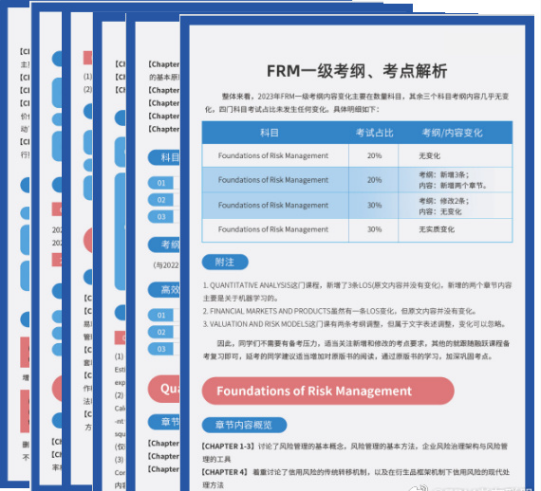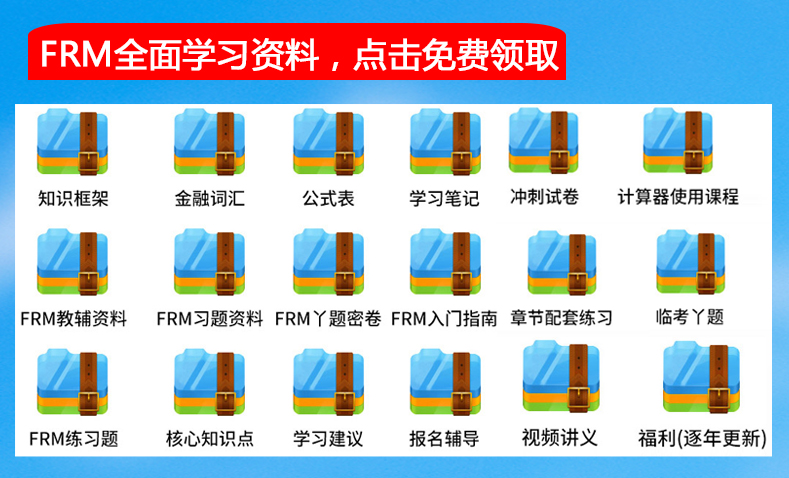12月1日GARP协会公布了FRMzui新考纲,整体考纲变化不大,2023年的FRM考纲中所有科目的权重没有发生变化。变化的科目主要是在一级的数量分析;二级的信用、操作和热点;其余科目基本保持不变。
》》》2023年新版FRM一二级内部资料免·费领取!【精华版】
PART 1 #金融风险管理
01.章节的变动
新增两个章节(14、15章)关于机器学习的内容,老考纲FRM二级热点部分有关于机器学习的内容,如今也加入到数量分析当中,并且新增了两个章节,说明它的内容比较重要,也另外一个层面说明FRM考试很贴合实际生活。其他章节共新增3条新考点。
02.具体内容的变动
Chapter 7: Linear Regression [QA-7]
新增1条:
● Estimate the correlation coefficient from the R2 measure obtained in linear regressions with a single explanatory variable.
Chapter 8: Regression With Multiple Explanatory Variables [QA-8]
新增1条:
● Calculate the regression R2 using the three components of the decomposed variation of the dependent variable data: the explained sum of squares, the total sum of squares, and the residual sum of squares.
Chapter 12: Measuring Returns, Volatility, and Correlation [QA-12]
新增1条:
● Compare and contrast the different measures of correlation used to assess dependence.
新增章节
● Chapter 14: Machine-Learning Methods [QA-14]
● Chapter 15: Machine Learning and Prediction [QA-15]
PART 1 #市场风险
01.具体内容的变动
Chapter 3. Estimating Market Risk Measures: An Introduction and Overview [MR–1]
删除1条:
● Describe coherent risk measures.
总结:市场风险内容变动不大,仅仅删除一条关于一致性风险的考点。
PART 2 #信用风险
01.具体内容的变动
Chapter 9:Structured Credit Risk [CR–8]
新增1条:
● Describe the treatment of excess spread in a securitization structure and estimate the value of the overcollateralization account at the end of each year.
Chapter 6: Netting, Close-out and Related Aspects [CR–10]
新增1条:
● Provide examples of trade compression of derivative positions, calculate net notional exposure amount, and identify the party holding the net contract position in a trade compression.
Chapter 7:Margin (Collateral) and Settlement [CR–11]
新增1条:
● Calculate the credit support amount (margin) under various scenarios.
Chapter 17. CVA [CR–13]
新增1条:
● Explain the distinctions between unilateral CVA (UCVA) and BCVA, and between unilateral DVA (UDVA) and BCVA.
Chapter 12. An Introduction to Securitization [CR–17]
删除1条:
● Determine the notional value of the net contract resulting from trade compression and identify the counterparty with the net contract.
新增3条:
● Describe the various features of subprime MBS and explain how these features are designed to protect investors from losses on the underlying mortgage loans.
● Distinguish between corporate credit ratings and asset-backed securities (ABS) credit ratings.
● Explain how through-the-cycle ABS rating can amplify the housing cycle.
总结:信用风险一共新增7个考点,删除1个考点。新增的内容都可能会是未来考试的重点部分,大家要引起重视,紧跟网课复习!
PART 2 #操作风险
01.章节的变动
原来27个章节,现在变成24个章节,对于原来分散的知识点进行了整合,使得整本操作风险变得更加系统,学生学起来能够更加容易理清思路,形成学习框架,即风险管理的步骤就是:风险识别、风险测量和评估、风险缓解、风险报告、综合风险管理。
以前FRM考生在备考时,总反映操作风险难学,现在协会也是针对性对于学习内容进行了优化,让学生更有系统性的学习,明白风险管理的逻辑,也更好应用于实践。
新考纲内容变动虽然比较大,但是总体章节内容少了3章,原来复杂分散的内容也变得更加整体,对于老考生和新考生来说都是有利的,相比以前复习起来会相对容易,大家也不必对于大幅度的考纲变动太过于担忧~
02.具体内容的变动
Chapter 1. Introduction to Operational Risk and Resilience [ORR-1]
Chapter 2. Risk Governance [ORR-2]
Chapter 3. Risk Identification [ORR-3]
Chapter 4. Risk Measurement and Assessment [ORR-4]
Chapter 5. Risk Mitigation [ORR-5]
Chapter 6. Risk Reporting [ORR-6]
Chapter 7: Integrated Risk Management [ORR–7]
Chapter 9. Case Study: Cyberthreats and Information Security Risks [ORR-9]
Chapter 10. “Sound Management of Risks related to Money Laundering and Financing of Terrorism,” Basel Committee on Banking Supervision, January 2014, revised July 2020. (through p.16, para. 83) [ORR-10]
Chapter 11. Case Study: Financial Crime and Fraud [ORR-11]
Chapter 13. Case Study: Third-Party Risk Management [ORR-13]
Chapter 14. Case Study: Investor Protection and Compliance Risks in Investment Activities [ORR-14]
Chapter 16. Case Study: Model Risk and Model Validation [ORR-16]
总结:上面13个章节都是新增章节,考生需要重新进行复习,17-24章内容保留了老考纲的内容,大约保留了1/3的内容,分别是以下内容:
Til Schuermann, (2014), “Stress Testing Banks,” International Journal of Forecasting, 30:3, 717–728. [ORR–17]
Chapter 17. Risk Capital Attribution and Risk-Adjusted Performance Measurement [ORR–18]
“Range of practices and issues in economic capital frameworks,” Basel Committee on Banking Supervision Publication, March 2009. [ORR–19]
“Capital Planning at Large Bank Holding Companies: Supervisory Expectations and Range of Current Practice,” Board of Governors of the Federal Reserve System, August 2013. [ORR–20]
Mark Carey, “Capital Regulation Before the Global Financial Crisis,” GARP Risk Institute, April 2019. [ORR-21]
Mark Carey, “Solvency, Liquidity and Other Regulation After the Global Financial Crisis,” GARP Risk Institute, April 2019. [ORR-22]
“High-level summary of Basel III reforms,” Basel Committee on Banking Supervision Publication, December 2017. [ORR-23]
“Basel III: Finalising post-crisis reforms,” Basel Committee on Banking Supervision Publication, December 2017, pp. 128-136. [ORR-24]
PART 2 #热点
01.章节的变动
保留了Artificial Intelligence/Machine Learning两篇文章,删除了6篇文章,新增了6篇热点文章,关于气候风险、通货膨胀风险、区块链、加密货币和去中心化金融。热点基本上每年都会变动,FRM考试就是紧跟时事变化,贴近现实生活,考FRM对于我们工作和学习帮助都是很大的。
保留的两篇文章:
Machine Learning and AI
● Aziz, S. and M. Dowling (2019). “Machine Learning and AI for Risk Management”, in T. Lynn, G. Mooney, P. Rosati, and M. Cummins (eds.), Disrupting Finance: FinTech and Strategy in the 21st Century, Palgrave, 2019)
● “Artificial Intelligence Risk & Governance,” Artificial Intelligence/Machine Learning Risk & Security Working Group (AIRS)
02.具体内容的变动
Climate Risk
● “Climate-related risk drivers and their transmission channels,” Basel Committee on Banking Supervision Publication, April 2021
● “Climate- related financial risks – measurement methodologies,” Basel Committee on Banking Supervision Publication, April 2021
● “Principles for the effective management and supervision of climate-related financial risks,” Basel Committee on Banking Supervision Publication, June 2022
Inflation Risk
● “Inflation: a look under the hood,” Annual Economic Report, Basel Committee on Banking Supervision Publication, June 2022, pp. 41-64
Blockchain, Cryptocurrency, and Decentralized Finance
● David Andolfatto and Fernando M. Martin, “The Blockchain Revolution: Decoding Digital Currencies,” Federal Reserve Bank of St. Louis Review, Third Quarter 2022, pp. 149-65
● “The future monetary system,” Annual Economic Report, Basel Committee on Banking Supervision Publication, June 2022, pp. 75-103
另附详细《23年FRM考纲分析》,点击在线咨询或者添加融跃FRM老师微信(rongyuejiaoyu)领取

- 报考条件
- 报名时间
- 报名费用
- 考试科目
- 考试时间
-
GARP对于FRM报考条件的规定:
What qualifications do I need to register for the FRM Program?
There are no educational or professional prerequisites needed toregister.
翻译为:报名FRM考试没有任何学历或专业的先决条件。
可以理解为,报名FRM考试没有任何的学历和专业的要求,只要是你想考,都可以报名的。查看完整内容 -
2024年5月FRM考试报名时间为:
早鸟价报名阶段:2023年12月1日-2024年1月31日。
标准价报名阶段:2024年2月1日-2024年3月31日。2024年8月FRM考试报名时间为:
早鸟价报名阶段:2024年3月1日-2024年4月30日。
标准价报名阶段:2024年5月1日-2024年6月30日。2024年11月FRM考试报名时间为:
早鸟价报名时间:2024年5月1日-2024年7月31日。
标准价报名时间:2024年8月1日-2024年9月30日。查看完整内容 -
2023年GARP协会对FRM的各级考试报名的费用作出了修改:将原先早报阶段考试费从$550上涨至$600,标准阶段考试费从$750上涨至$800。费用分为:
注册费:$ 400 USD;
考试费:$ 600 USD(第一阶段)or $ 800 USD(第二阶段);
场地费:$ 40 USD(大陆考生每次参加FRM考试都需缴纳场地费);
数据费:$ 10 USD(只收取一次);
首次注册的考生费用为(注册费 + 考试费 + 场地费 + 数据费)= $1050 or $1250 USD。
非首次注册的考生费用为(考试费 + 场地费) = $640 or $840 USD。查看完整内容 -
FRM考试共两级,FRM一级四门科目,FRM二级六门科目;具体科目及占比如下:
FRM一级(共四门科目)
1、Foundations of Risk Management风险管理基础(大约占20%)
2、Quantitative Analysis数量分析(大约占20%)
3、Valuation and Risk Models估值与风险建模(大约占30%)
4、Financial Markets and Products金融市场与金融产品(大约占30%)
FRM二级(共六门科目)
1、Market Risk Measurement and Management市场风险管理与测量(大约占20%)
2、Credit Risk Measurement and Management信用风险管理与测量(大约占20%)
3、Operational and Integrated Risk Management操作及综合风险管理(大约占20%)
4、Liquidity and Treasury Risk Measurement and Management 流动性风险管理(大约占15%)
5、Risk Management and Investment Management投资风险管理(大约占15%)
6、Current Issues in Financial Markets金融市场前沿话题(大约占10%)查看完整内容 -
2024年FRM考试时间安排如下:
FRM一级考试:
2024年5月4日-5月17日;
2024年8月3日(周六)上午;
2024年11月2日-11月15日。FRM二级考试:
2024年5月18日-5月24日;
2024年8月3月(周六)下午;
2024年11月16日-11月22日。查看完整内容
-
中文名
金融风险管理师
-
持证人数
25000(中国)
-
外文名
FRM(Financial Risk Manager)
-
考试等级
FRM考试共分为两级考试
-
考试时间
5月、8月、11月
-
报名时间
5月考试(12月1日-3月31日)
8月考试(3月1日-6月30日)
11月考试(5月1日-9月30日)









